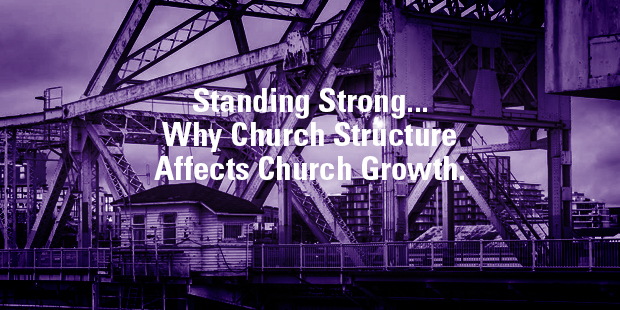
Standing Strong…Why Church Structure Affects Church Growth
Structure is essential.
Like a body without bones or a building without supporting walls, an organization without a structure goes nowhere, fast.
Having said that, it’s important to understand that only healthy structure supports growth. Unhealthy structure holds organizations back from growing.
Todd Henry, author of Louder Than Words, says this,
The more structures we have to navigate in order to do our work, the more difficult it is to do our best work. When we are required to resolve the dissonance of complex systems, reporting relationships, and accountability structures just in order to get our objectives and check off our direction, we will begin to lose our drive to do brilliant work. Over time, this complexity only pulls entire organizations toward systematic mediocrity.
(Discovered via Tony Morgan’s short book, Stuck in a Funk?: How to Get Your Church Moving Forward)
The more complex an organization becomes, the more room there is for communication leaks. Information and instruction gets lost, tweaked, and twisted as it moves between all the different layers and channels.
This explains why government bureaucracies have such bad reputation. There are so many arbitrary rules and regulations, implemented at different times and for different reasons that it winds up being pretty tough to get a final decision from anyone.
In tech startups, however, a seemingly large business may consist of only a handful of remotely-working entrepreneurs. These organizations can often make decisions quickly and with agility.
One of the features of Saddleback Church that amazes me is the speed with which decisions and instructions can be carried out. The elders believe in passing decision-making authority down to the lowest possible level. With fewer layers of approval needed, leaders could make changes quickly.
I often thought of the Saddleback staff as a flock of birds. Pastor Rick Warren was out front, leading our v-formation. When his direction would suddenly shift, the church’s staff could quickly adjust and follow right along.
So, what does this look like for your local church? What does an unhealthy structure look like contrasted with a healthy structure?
Churches with unhealthy structures:
- Have too many committees.
- Vote on too many issues.
- Lack simple, written parameters for decision-making.
- Spread authority out randomly.
- Move slowly to allow everyone’s turf to remain safe.
Churches with healthy structures, on the other hand:
- Have high trust in their leaders.
- Give responsibility to more leaders whenever possible.
- Have few or no committees.
- Don’t vote on almost any issues at all.
- Are able to move and change more quickly.
Can an unhealthy structure be overcome? Possibly, but it takes a long time. There is usually a lot of foundational work that has to be done, especially in the trust-building department. People avoid change because of the fear of losing control, and fear is a very powerful emotion to try to overcome.
One of the issues I often coach leaders about is how to create a healthy, growth-oriented and life-giving culture that allows the structure to be changed.
An unhealthy structure doesn’t necessarily kill churches and organizations, but it can definitely keep them sick and weak.
Change the culture, and then address the structure. Sometimes an overhaul is the only sensible answer.

Tags: Brandon Cox, Church Structure, Leadership











